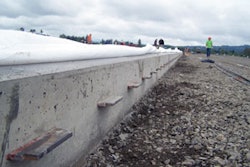Defect litigation presents a financial challenge to the concrete industry, and 2009 is unlikely to see any improvement in that regard. Whether fairly or not, concrete gets tainted by defects in other aspects of construction, both residential and commercial. That is to say, roof and window leaks seem to precede most complaints about the concrete. And when homeowners see the value of their homes fall dramatically, they can't help but wonder if a builder's negligence contributed to that loss of value. We've all seen from Wall Street to Washington that values have tumbled, and we can all expect litigation to increase because of this 2008 drain on equity.
In California, defect litigation proceeds unabated, and the concrete industry faces similar legal challenges in Arizona, Nevada and other states. Allegations of sulfate attack or related complaints about defective concrete are all too common.
Refuting allegations of sulfate attack, for example, requires hundreds of hours of expert analysis and testimony. Never mind that the Castron v. Fieldstone case in Orange County, Calif., demonstrated that claims of sulfate attack are often based on "junk science." The judge in the Castron trial lamented that junk science should not be used to "bludgeon" defendants - in this case defendant National Ready Mix Concrete Corporation - into costly settlements. Yes, National Ready Mix prevailed at trial, but at what cost? There is little to prevent plaintiffs in other cases making similar allegations. Castron was just one in the line of so much litigation that some describe it as "Same case, different zip code." Except unlike the vast majority of cases, a judge spent nearly one year of his life hearing the evidence. Ultimately, the defendant's insurance companies, when policies are still in force, can usually elect to settle them rather than incur the expense of a trial, even when they believe allegations are unfounded.
Due to the current legal environment and changing standards of practice, concrete contractors, suppliers and design professionals in the residential concrete business all are at additional risk of multimillion-dollar construction defect lawsuits. California's Right to Repair Law (SB 800) and similar legislation make defect litigation involving concrete even more complicated.
In November, Arizona voters defeated Proposition 201, the so-called "Homeowners' Bill of Rights," which construction and concrete industry representatives believed, if passed, would have spawned yet more defect litigation.
There are five common areas of defect allegations regarding concrete: sulfate attack, salt-induced distress, vapor emissions, "significant cracking" and corrosion of embedded metal. And in California, certain elements of SB 800 are just now being applied to residential concrete, including significant cracking, moisture emissions and claimed violations of building code requirements.
Ongoing sulfate attack litigation, also known as "the sulfate wars," is the most complex. It's based upon the premise the sulfate-laden water from the soils beneath enter concrete of poor durability, leading to distress within the concrete through the creation of secondary minerals, thus weakening the concrete and making the system even more permeable and susceptible. Numerous engineering, geologic, chemical and scientific disciplines are required to evaluate these complex claims by plaintiffs.
A frequent allegation often includes the claim about "porous and permeable concrete," or what I call "sulfate lite." These cases hinge on the notion that the concrete is defective fundamentally because it has a water-to-cement (or cementitious, w/cm) ratio that is too high and neglect completely the complicated topic of sulfate reactions. The claim concludes that because of the high w/cm, the concrete is therefore too porous and permeable, thus allowing moisture or water vapor to pass through it, consequently damaging flooring materials or contents.
Moisture "transmission" is the needed common "proof" in claims of damage by sulfate attack and moisture penetration. Thus, attorneys argue the moisture or water vapor damaged the structure and/or contents above the concrete, especially the flooring. (I will address the flooring issue in a future column.)
This is not to say there are not legitimate claims of defective concrete. There are. I have investigated, for example, instances where the use of certain packaged materials have resulted in defective products and installations. And I have seen instances of serious defects caused simply by poor workmanship.
However, many of my investigations concern allegations that have been shown to be based on theories that do not hold up when they are examined by accepted scientific principles and methods.
For example, in a number of cases, expert witnesses have argued that scanning electron microscopy and energy-dispersive x-ray spectroscopy (SEM/EDX) methods are valid as stand-alone tools when analyzing concrete. However, when shown SEM images of a number of predominately carbon-based compounds, under oath one expert could not distinguish between a diamond and a graphite pencil lead or a lump of coal. In another instance, an expert concluded that, because of the peak ratio of calcium to silica and the rest of the EDX spectra, the material was likely hydrated cement, possibly undergoing sulfate attack. In fact, the sample was a Tums antacid tablet!
Unscientific methods are used to support claims of high moisture content and unacceptable levels of vapor emissions from hardened concrete. The oft-cited vapor emissions test recommended by the flooring industry, for example, is unreliable in predicting or preventing flooring distress. But to be refuted in a court of law, such claims require costly investigations.
What precautionary measures may be appropriate for concrete suppliers, contractors and design professionals to address their potential exposure to litigation and reduce their risk? One method may include installing concrete with a 0.45 w/cm ratio using Type V cement and 4,500 psi concrete, since plaintiffs argue this is a "bright line" codified standard. But the only residences built to this claimed specification are those built in response to litigation claiming sulfate attack. I don't recommend this for a variety of reasons: It will increase the cost of the foundation, waste cement, may be environmentally backward and in my opinion is just wasted money and resources.
One sure way to avoid expensive concrete litigation is to get out of the concrete business. Barring that draconian measure, buy insurance, if you can get it, then read the policy carefully and diligently address and shift risks regarding all duties or responsibilities associated with flooring standards. Nowadays, contractors frequently can't obtain insurance, and self-insure, sometimes citing this as an advantage with respect to spurious litigation.
Also, since flooring standards are being imposed on the concrete contractor, some choose to limit liability by writing a letter to the general contractor saying they cannot be responsible for flooring standards or flooring failures, and that the concrete will be installed per the specs given.
Good luck and best wishes for 2009.


![Fcp Racatac Chair 10893876[1]](https://img.forconstructionpros.com/mindful/acbm/workspaces/default/uploads/2025/10/fcp-racatac-chair-108938761.10l0At5WXv.png?auto=format%2Ccompress&bg=fff&fill-color=fff&fit=fill&h=100&q=70&w=100)









![Fcp Racatac Chair 10893876[1]](https://img.forconstructionpros.com/mindful/acbm/workspaces/default/uploads/2025/10/fcp-racatac-chair-108938761.10l0At5WXv.png?ar=16%3A9&auto=format%2Ccompress&bg=fff&fill-color=fff&fit=fill&h=135&q=70&w=240)






